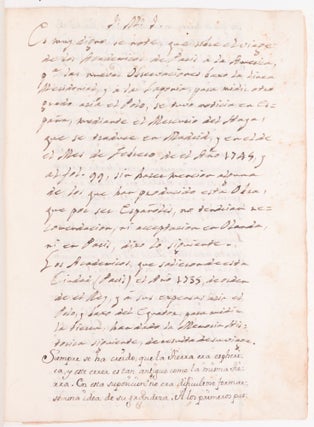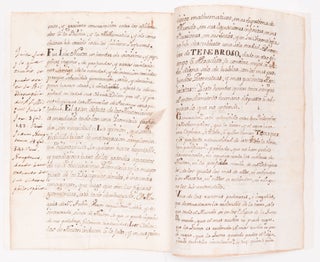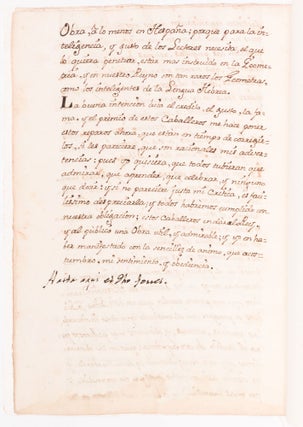18th-Century Manuscript On the Spanish Role in the French Geodesic Mission, and the Figure of the Earth.
[Spain]: [after 1752]. 18th-century manuscript. Text in Spanish. 24 handwritten pages in ink, in three different hands. ff [12]. Later binding of blank paper using old material. Tiny wormholes at the lower edge of the pages on the first 7 leaves, not affecting the legibility. Occasional foxing, ink ghosting. Water stains on the last 2 leaves. Overall in fine condition.
18th-Century Spanish manuscript about the Spanish involvement in the French Geodesic Mission of 1735 and the Ellipsoid Model of the Earth.
The manuscript is an interesting collection of contemporary reports proving the importance of the Spanish role performed by Jorge Juan y Santacilia and Antonio de Ulloa in the so-called French Geodesic Mission (1735), with a particular focus on the polemic over the shape of the Earth. The quotations are conjugated with connecting texts by an anonymous author.
One of the important scientific disputes of the late 17th, early 18th century was the debate on the shape of the Earth. The assumption of the spherical shape was dominating until the late 17th century when Sir Isaac Newton determined that the Earth was oblate, a spheroid stretched over the Equator, however at the same time Giovanni Domenico Cassini, and his son Jacques, supposed that the Earth was prolate (stretched along the poles). Eventually, in 1735 two expeditions were sent by Louis XV and the French Academy to the Arctic Circle (Lapland) and to the Equator (Ecuador and Peru) to gain certainty by measuring the meridian arcs at polar and equatorial latitudes. The equatorial mission was accompanied by two Spanish geographers Jorge Juan y Santacilia and Antonio de Ulloa, thus it became the first major international scientific expedition. The findings of the missions confirmed Newton’s hypothesis that the Earth was oblate, a rotational ellipsoid.
The first part of the manuscript is a lengthy citation of an early Spanish report on the equatorial mission, published in the Mercurio histórico y político (February 1745; pp. 99–107), which is followed by further references and quotations related to the geographer’s, their work, and the figure of the Earth, such as Benito Jerónimo Feijóo y Montenegro’s Theatro critico universal (1751), Bernardo’s de Ulloa’s (Antonio’s father) Restablecimento de las fabricas y comercio español (1749), and articles from the Journal de Trévoux or the Gaceta de Zaragoza. The second part is Diego de Torres Villarroel’s (1693–1770) study, Prevenciones (in: Libros en que estan reatados. Vol. IV.; 1752) in which de Torres, the almanac writer, and professor of mathematics of a dubious repute, opposes the findings of the missions and Newton’s hypothesis of the oblate Earth.
Antonio de Ulloa (1716–1795) was a Spanish scientist and explorer, the first Spanish governor of Louisiana, who is also credited as the discoverer of the element platinum. De Ulloa was a Fellow of the Royal Society and a foreign member of the Royal Swedish Academy of Sciences. His associate Spanish scientist in the Geodesic Mission to Peru was Jorge Juan y Santacilia (1713–1773), who during the mission also measured the heights of the mountains of the Andes. Jorge Juan was the founder of the Real Observatorio de Madrid (Royal Observatory of Madrid) and he became a Fellow of the Royal Society too. Their co-written memoirs were published in Spanish from 1748 on, and their books were very soon translated into French, English, and German.
Literature: Lafuente, A.; Mazuecos, A.: Gentlemen of the Fixed Point: Science, Politics and Adventure in the Geodesic Expedition to the Viceroyalty of Peru in the XVIII Century. pp. 171–203. Retrieved on July 8, 2020 from https://digital.csic.es/bitstream/10261/15737/7/Gentlemen_of_the_Fixed_Point_Chapter_5.pdf; Mayboudi, L. S.: (chapter 5.1) In: Geometry Creation and Import With COMSOL Multiphysics. Dulles (VA, USA): Mercury Learning & Information, 2019.; Richardson, D.; [et al]: The International Encyclopedia of Geography People, the Earth, Environment, and Technology: Chichester, UK; Hoboken, NJ: John Wiley & Sons, 2017.
.
Price: €7,000.00




